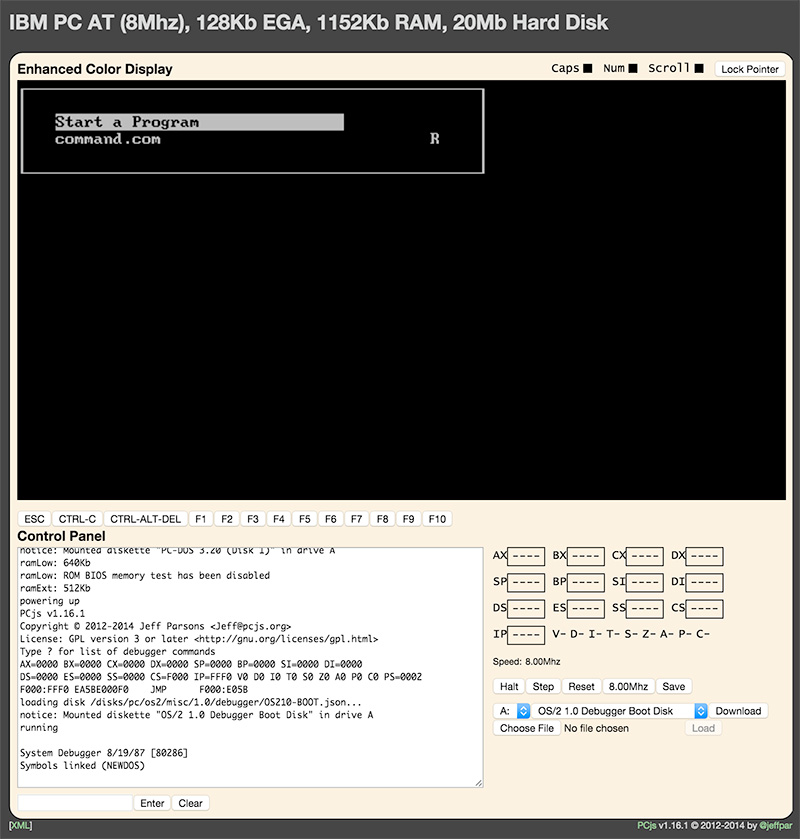PCjs Machines
Home of the original IBM PC emulator for browsers.

PCjs Blog
OS/2 1.0
Exciting news for OS/2 fans: PCjs (v1.16.1) is now able to run OS/2 1.0 on IBM PC AT Machine Configurations. This is the culmination of recent work in PCjs to fully emulate the Intel 80286 processor and 16-bit protected-mode, including undocumented features like LOADALL and triple-fault resets.
For a quick demo, try the OS/2 1.0 Debugger Disk. In a few seconds, you’ll see a very rudimentary OS/2 shell (a slimmed-down version of the OS/2 Program Selector) that allows you to start the protected-mode command interpreter (“Start a Program”) or the real-mode command interpreter (“command.com”).
As an added bonus, the Model 5170 machines feature two serial ports, with COM1 connected to a simulated serial mouse and COM2 connected to the PCjs Debugger output window.
Once you’ve booted the OS/2 1.0 Debugger Disk from the assortment of OS/2 Prototype Disks, you can click on the PCjs Debugger output window, press Ctrl-C, and find yourself magically transported into the OS/2 Kernel Debugger. The PCjs Debugger display is functioning as both the output window for all PCjs messages and PCjs Debugger commands, as well as a serial input/output device (aka “Dumb Terminal”) for any software inside the machine communicating via COM2: in this case, the OS/2 Kernel Debugger.
SIDEBAR: You can perform similar tricks with DOS in these machines. Boot any DOS disk (version 2.00 and up) and type “CTTY COM2” at the DOS prompt. All DOS input/output will now be routed to the Debugger display. To restore control to the the machine’s keyboard and video display, type “CTTY CON”.
Type “?” for a list of all OS/2 Kernel Debugger commands. Type “g” to continue running OS/2. Make sure you type all OS/2 Kernel Debugger commands into the PCjs Debugger output window. Commands typed into the input box beneath the output window are processed only by the PCjs Debugger.
When a fault occurs, OS/2 normally displays a “TRAP” message; however, when the Kernel Debugger is running, it intercepts the fault and displays the faulting instruction. But the PCjs Debugger has ultimate control: using the “m fault on” and “m halt on” commands, the PCjs Debugger will display and halt on any fault first. If you want PCjs to deliver the fault to OS/2, single-step over the faulting instruction and then continue.
There are still a number of known issues running OS/2. For example, when attempting to install OS/2 1.0 from the installation diskette images onto a hard disk image, OS/2 successfully formats the hard disk and copies the files from the first two diskettes, but usually while copying files from either the second or third diskette, the process stops. There’s no crash – it simply stops copying files and never finishes. My best guess at this point is that some interrupts are being dropped.
Similarly, if a machine running OS/2 1.0 is left unattended for a few minutes, it may stop responding. Again, there’s no crash or other indication of a problem. The machine simply appears hung. “Ctrl-Alt-Del” and “Reset” buttons still work.
The journey continues.
Jeff Parsons
Dec 4, 2014
